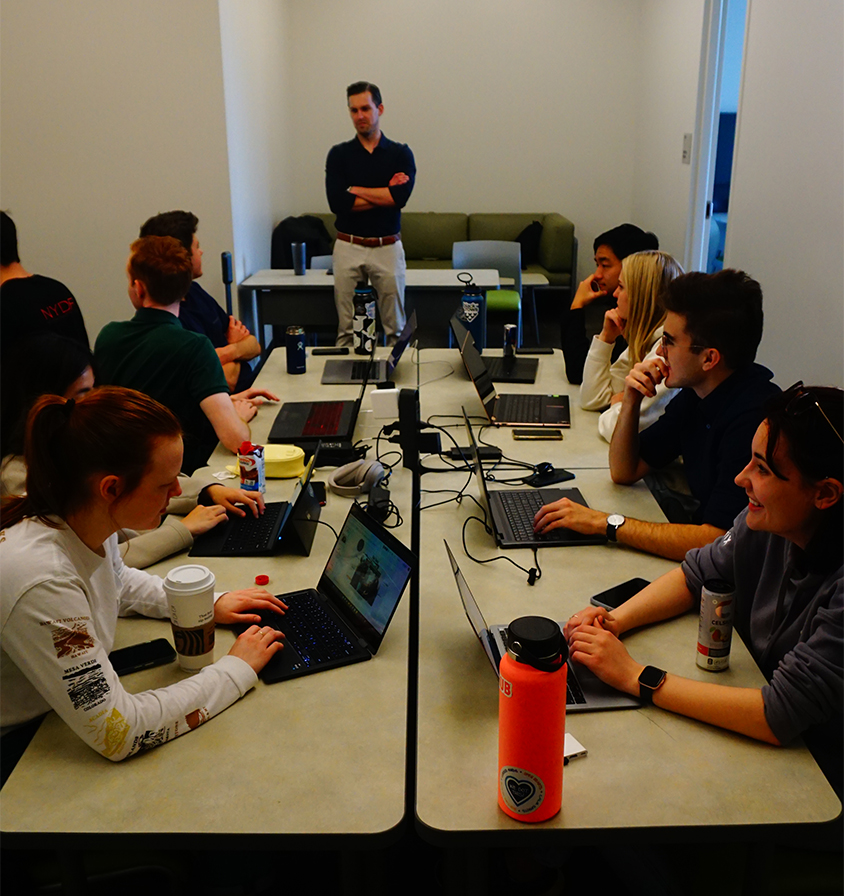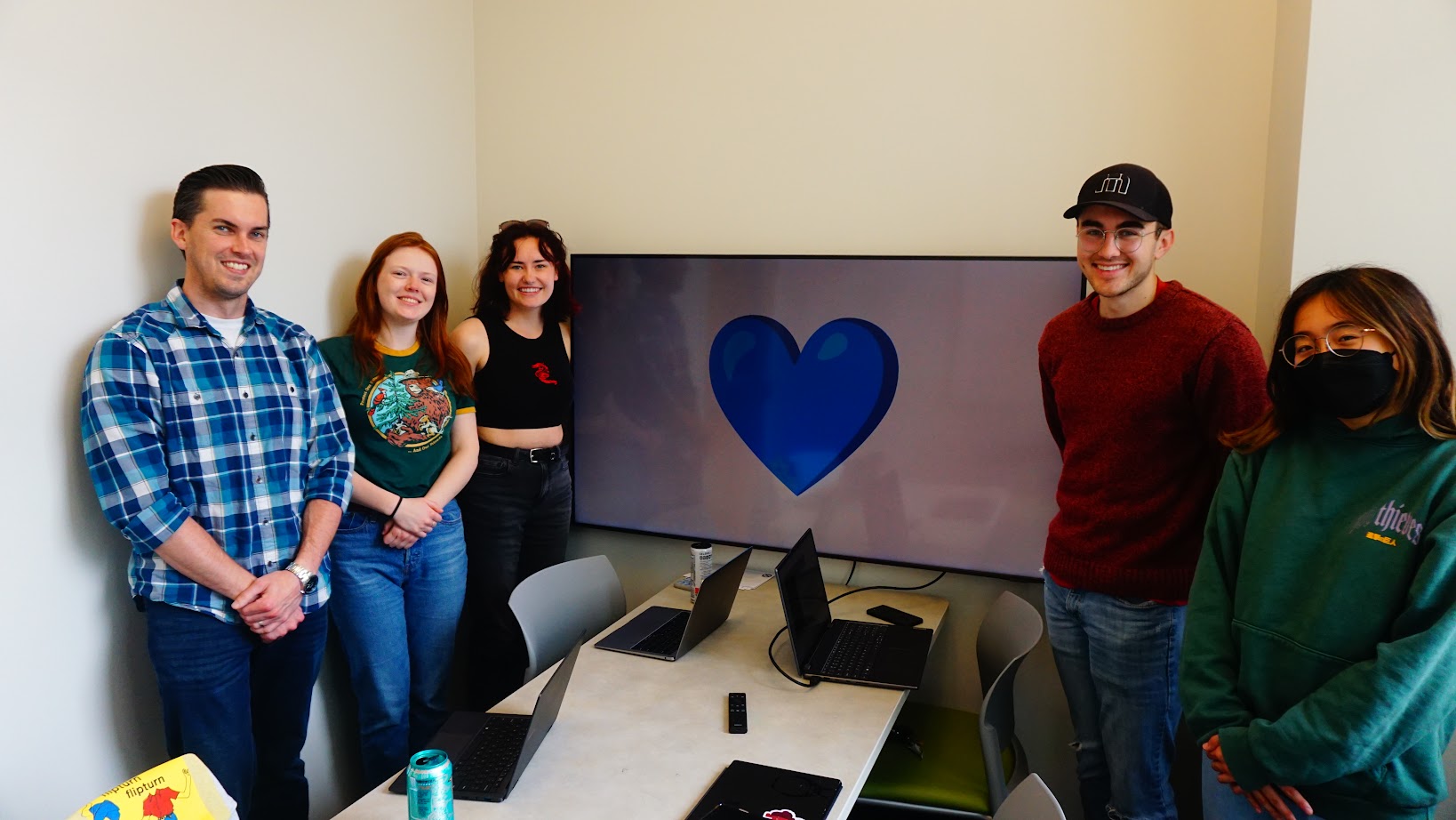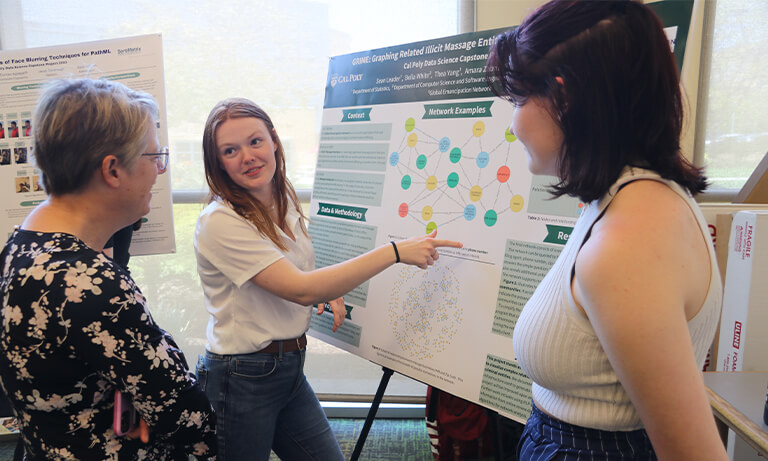Content warning: This story discusses sex trafficking.
Organizations combatting human trafficking are using a powerful new network built by a team of Cal Poly students in the data science capstone that uncovers connections between co-conspirators to identify businesses engaged in a modern form of slavery.
“Anti-trafficking stakeholders at home and abroad have seen this system and now are taking action,” said Sherrie Caltagirone, executive director and founder of the Global Emancipation Network, or GEN, a nonprofit dedicated to disrupting human trafficking.
She met the team – a computer science student and three statistics students – through the Cross-Disciplinary Studies Minor in Data Science program led by Computer Science Professor Alex Dekhtyar and Statistics Professor Hunter Glanz. In the 20-week capstone, students are paired with a professional client to solve a real-world problem.
Caltagirone’s team took on the challenge of building and training a network with data from massage businesses in Colorado that could help agencies and law enforcement find illicit operations – the No. 1 face of sex trafficking, according to Caltagirone.
Soon after the team presented GEN with the code, she took the network to officials at the California Department of Justice, stakeholders in Texas and law enforcement officers across the United Kingdom.
“This system allows stakeholders to access data in a new way, and they already are seeing results,” she said, pointing to an undisclosed investigation in California where the data is playing a significant role.

What is the network telling us?
Professors Dekhtyar and Glanz formed the team of students eager to help the Global Emancipation Network disrupt the trafficking organizations that exploit 21 million men, women and children each year.
“I wanted to play a part in dismantling the networks behind human trafficking,” said member Bella White, a blended master’s student in computer science. “If we are spending two quarters on this project, why not try to make a really big impact?”
Other members included statistics majors Sean Leader, Thea Yang and Amara Zabback.
Caltagirone has partnered with the data science program since the start, integrating information students collect with her nonprofit’s data that is shared free of charge with law enforcement, government agencies, researchers, academia and anti-trafficking nonprofits.
She gave White, Leader, Yang and Zabback wide latitude to decide the direction on their project, with the group opting to build their network using data on massage businesses in Colorado.
Unlike in California, massage businesses in Colorado are required to register with the state, which has resulted in data readily accessible to researchers like the Cal Poly team.
“GEN had done the work of identifying illicit massage businesses, but our goal was to build a social network graph to find connections between operations that are illicit and those that look legit,” said Zabback, a fifth-year statistics student. “If businesses had the same phone number, ZIP code or filing agent, we looked closer.”
She explained that a social network graph is a diagram used to illustrate interconnections between entities. In this case, entities included business owners, agents, customers and massage therapists, who also could be trafficking victims.
They created a node for each entity, then looked for edges they could draw between entities.
“In the beginning, we weren’t sure if we would find those connections,” said Thea Yang, who graduated in spring with a statistics degree. “We were acquiring data, cleaning and coding and then we began to find connections – meaningful insights that start to tell a story.”
In one case, Zabback said, an illicit massage business was shut down but the same people at the same location using the same phone number had opened a massage business under a different name – a connection the team charted for Caltagirone.
“The main thing to consider is: What is the network telling us?” said Leader, who will continue his master’s degree at Cal Poly next year. “We aren’t the judge but are providing a tool to narrow down the data that can be used by law enforcement.”

Not just data points
The amount – and content – of the data the team had to process over the 20-week capstone required them to hone new skills in network analysis while mitigating the effects on their own mental health.
Zabback’s focus was natural language processing, which involved reading massage customers’ reviews on websites, including one that publishes reviews for illicit massage businesses offering sex services for sale.
“When I first started looking at these reviews, I had to stop after 5 to 10 minutes and step away,” she said. “This is a heavy topic I hadn’t been trained to digest, so I had to make sure I was taking care of myself.”
White, who was tasked with setting up the infrastructure to store the data, echoed Zabback.
“These sexual acts described in horrific, graphic details are real things that happened to real people, not just data points,” she said.
The team started with a basic understanding of human trafficking, but as they conducted their research, they gained a deeper understanding of the extensive and intricate operations involved in exploiting so many people.
“I knew that human trafficking was a problem, but I was completely unaware of this avenue – that massage businesses could be a front for sex trafficking,” said Leader, who handled the data cleaning to ensure it functioned in the network.
The primary insight that drove the project, Leader said, was the humanity and vulnerability of the sex workers: “We wanted to make sure the needs of the victim are prioritized.”
Yang, who learned to interface with new software for the network, is the only member who won’t be returning to Cal Poly for further or continuing studies.
“I’m glad I got to participate in work that involved social justice, activism and women’s rights – a heavy part of my values,” she said. “I got to finish my Cal Poly education with a project that mattered the most.”
White, who is wrapping up her computer science degree, is aiming to publish a paper on the team’s findings, so they can share their technique: “We wanted to provide a tool that can be used to interpret data easily.”
Caltagirone will continue sharing the system she calls data agnostic for its capability to be retrained with different sets of data.
“We can not only look at illicit massage businesses but their connections to other companies – transport, restaurants, nail salons – organized crime beyond sex trafficking,” she said. “Amazing things are possible when we have academic/industry collaborations like this.”
By Emily Slater

By the Numbers
- Approximately 21 million men, women and children are trafficked each year across the globe (with 7 out of 10 of those impacted being women and girls)
- Fewer than 50,000 of these victims are identified and rescued
- Human trafficking generates an estimated $50 billion annually for traffickers and organized criminal networks
Source: Global Emancipation Network


